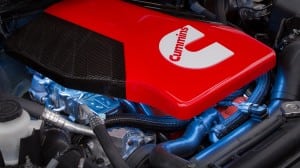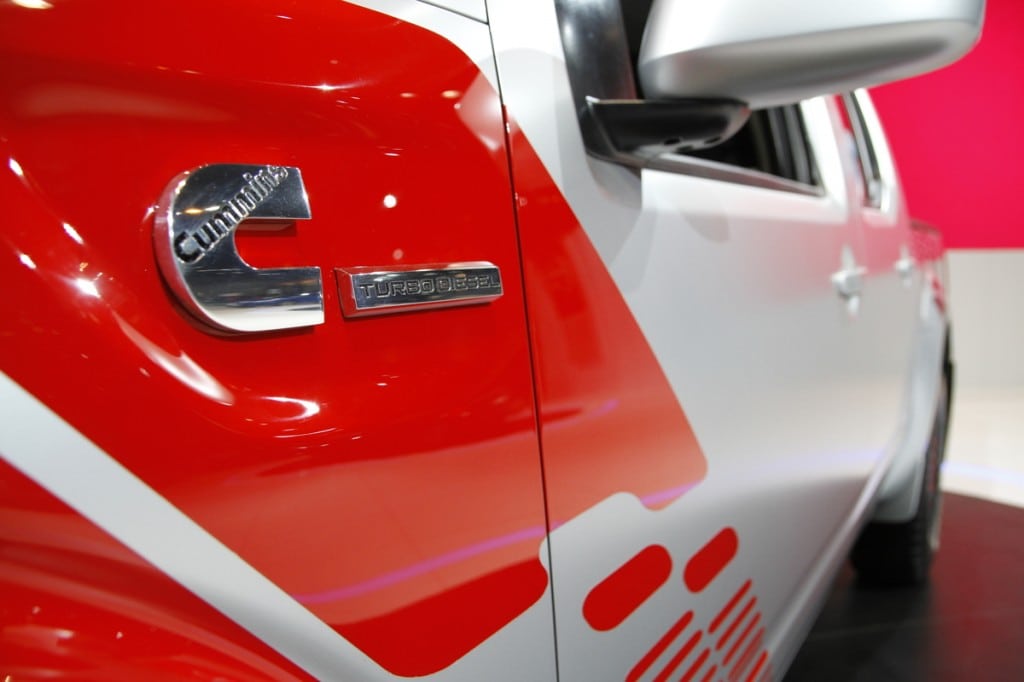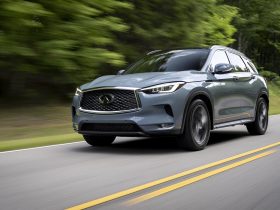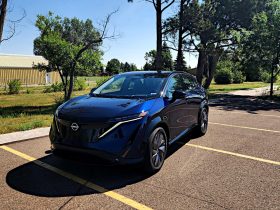At the Chicago Auto Show early this month, Nissan unveiled a “project truck” called the Frontier Diesel Runner Project Truck Powered by Cummins. A mouthful, sure, but it’s name spells out its purpose. The truck itself looks great, but most of what made people excited was what’s going on under the transparent hood it sports.
The idea is pretty simple and has been something that Nissan and partner Cummins have been working on since at least 2010. When the company announced that the new design of the Titan full-sized truck would include a diesel engine option, it ignited commentary on the entry of diesel engines into the half-ton truck market. Nowhere in that commentary did the idea of a mid-sized truck with diesel power seem to be mentioned.
Yet now, with hindsight, it should have been obvious. If Nissan joined forces with Cummins, it would be on more than one offering. After all, the Titan isn’t exactly a top-selling truck. In fact, it’s basically the worst-selling truck in the North American market. There are reasons for that and they aren’t entirely Nissan’s fault – mostly they’re about what truck buyers want and how brand loyal truck buyers tend to be. Yet in the midsize pickup truck market, Nissan holds its own as one of the last being offered here.
So would anyone buy a Nissan Frontier Diesel if it were offered?
Well, the Frontier itself is already a pretty great little truck. It’s easily the best offroad machine in the segment and in our review, we got a lot of mud on it to make sure of that. Adding in a fuel efficient, 200 horsepower, 350 lb-ft engine would definitely produce lustful fantasies for small truck lovers. We’re talking about a 2.8-liter diesle engine that outperforms the current V6 gasoline offering in the Frontier by a long shot. On every front. Including 35 percent better fuel economy than its gasoline counterpart.
 Although midsize truck buyers are not very likely to be concerned with fuel economy, Nissan is. All truck makers are. Corporate Average Fuel Economy (CAFE) standards are looming and right now, trucks are the one group of automobile that are furthest away from reaching the mandated goal the EPA has set. We’ve already seen the moves in full-sized pickups as Chrysler-Fiat introduced the diesel-powered Ram 1500, Ford introduced the light-bodied F-150, and rumors abound that Chevrolet and Toyota are considering diesel options for their half-ton trucks.
Although midsize truck buyers are not very likely to be concerned with fuel economy, Nissan is. All truck makers are. Corporate Average Fuel Economy (CAFE) standards are looming and right now, trucks are the one group of automobile that are furthest away from reaching the mandated goal the EPA has set. We’ve already seen the moves in full-sized pickups as Chrysler-Fiat introduced the diesel-powered Ram 1500, Ford introduced the light-bodied F-150, and rumors abound that Chevrolet and Toyota are considering diesel options for their half-ton trucks.
So why not the Frontier too? It would give Nissan more leverage and buying power with their partner, Cummins, and would give them a small edge against the Toyota Tacoma in the mid-sized market and a bigger edge against the newcomer, the Chevrolet Colorado, which will also offer a similar-sized diesel engine, by 2016.
The Nissan Frontier Diesel Project Truck includes that Cummins engine as well as a new eight-speed transmission offering, both of which are products of Nissan’s partnership with Cummins in the U.S. government’s ATLAS project for a next-generation, four-cylinder diesel engine in light automotive.
As diesel engines enter a new vogue with American buyers, especially in trucks now that they’ve been powering heavy-duty trucks for decades, the time may be ripe for Nissan to get on board a mid-sized diesel offering. Especially if they want to keep competing against sales leader Toyota and returning newcomer GM.
As shown, the Nissan Frontier Diesel Runner is a great truck. Nissan says that the showing at Chicago was to gauge consumer interest, but it seems more likely that they were just as interested in seeing how the media and other manufacturers would respond. Most of the media response has been hugely positive, unlike the more lackluster interest shown for the diesel Duramax mention that was given for the Colorado and Canyon twins from GM.
There is definitely a market for a Frontier Diesel, it’s just a question of how large that market might be. Large enough to augment a similar market interested in the Titan with a 5.0L diesel so that Nissan can better leverage its new partnership with Cummins? Probably.
To further speculate, what if this partnership extends to include some cars or SUVs in the diesel offering lineup? That’s an interesting question and one I think may be worth pondering as we consider the emergence of diesel powertrains into steady popularity in the North American automotive market.
-
 Nissan is renewing its commitment to the mid-size pickup segment, long a part of its sales success in the United States, with the creation of the Frontier Diesel Runner Powered by Cumminsª. This project truck, based on a Frontier Desert Runner 4x2 model, serves to both gauge the market reaction to a Nissan mid-size pickup with a diesel engine and plot a potential future direction for the Frontier.
Nissan is renewing its commitment to the mid-size pickup segment, long a part of its sales success in the United States, with the creation of the Frontier Diesel Runner Powered by Cumminsª. This project truck, based on a Frontier Desert Runner 4x2 model, serves to both gauge the market reaction to a Nissan mid-size pickup with a diesel engine and plot a potential future direction for the Frontier. -
 Nissan is renewing its commitment to the mid-size pickup segment, long a part of its sales success in the United States, with the creation of the Frontier Diesel Runner Powered by Cumminsª. This project truck, based on a Frontier Desert Runner 4x2 model, serves to both gauge the market reaction to a Nissan mid-size pickup with a diesel engine and plot a potential future direction for the Frontier.
Nissan is renewing its commitment to the mid-size pickup segment, long a part of its sales success in the United States, with the creation of the Frontier Diesel Runner Powered by Cumminsª. This project truck, based on a Frontier Desert Runner 4x2 model, serves to both gauge the market reaction to a Nissan mid-size pickup with a diesel engine and plot a potential future direction for the Frontier. -
 Nissan is renewing its commitment to the mid-size pickup segment, long a part of its sales success in the United States, with the creation of the Frontier Diesel Runner Powered by Cumminsª. This project truck, based on a Frontier Desert Runner 4x2 model, serves to both gauge the market reaction to a Nissan mid-size pickup with a diesel engine and plot a potential future direction for the Frontier.
Nissan is renewing its commitment to the mid-size pickup segment, long a part of its sales success in the United States, with the creation of the Frontier Diesel Runner Powered by Cumminsª. This project truck, based on a Frontier Desert Runner 4x2 model, serves to both gauge the market reaction to a Nissan mid-size pickup with a diesel engine and plot a potential future direction for the Frontier. -

-
 Nissan is renewing its commitment to the mid-size pickup segment, long a part of its sales success in the United States, with the creation of the Frontier Diesel Runner Powered by Cummins. This project truck, based on a Frontier Desert Runner 4x2 model, serves to both gauge the market reaction to a Nissan mid-size pickup with a diesel engine and plot a potential future direction for the Frontier.
Nissan is renewing its commitment to the mid-size pickup segment, long a part of its sales success in the United States, with the creation of the Frontier Diesel Runner Powered by Cummins. This project truck, based on a Frontier Desert Runner 4x2 model, serves to both gauge the market reaction to a Nissan mid-size pickup with a diesel engine and plot a potential future direction for the Frontier. -

-

-

-
 Nissan is renewing its commitment to the mid-size pickup segment, long a part of its sales success in the United States, with the creation of the Frontier Diesel Runner Powered by Cummins. This project truck, based on a Frontier Desert Runner 4x2 model, serves to both gauge the market reaction to a Nissan mid-size pickup with a diesel engine and plot a potential future direction for the Frontier.
Nissan is renewing its commitment to the mid-size pickup segment, long a part of its sales success in the United States, with the creation of the Frontier Diesel Runner Powered by Cummins. This project truck, based on a Frontier Desert Runner 4x2 model, serves to both gauge the market reaction to a Nissan mid-size pickup with a diesel engine and plot a potential future direction for the Frontier. -
 CHICAGO (Feb. 6, 2014) - Nissan is out and about at the 2014 Chicago Auto Show to hear from its customers, and to deliver what they want. Consumers have a chance to see what the brand has to offer, and could potentially offer, from across a broad spectrum of its innovative lineup.
CHICAGO (Feb. 6, 2014) - Nissan is out and about at the 2014 Chicago Auto Show to hear from its customers, and to deliver what they want. Consumers have a chance to see what the brand has to offer, and could potentially offer, from across a broad spectrum of its innovative lineup. -

-

-
 Nissan is renewing its commitment to the mid-size pickup segment, long a part of its sales success in the United States, with the creation of the Frontier Diesel Runner Powered by Cumminsª. This project truck, based on a Frontier Desert Runner 4x2 model, serves to both gauge the market reaction to a Nissan mid-size pickup with a diesel engine and plot a potential future direction for the Frontier.
Nissan is renewing its commitment to the mid-size pickup segment, long a part of its sales success in the United States, with the creation of the Frontier Diesel Runner Powered by Cumminsª. This project truck, based on a Frontier Desert Runner 4x2 model, serves to both gauge the market reaction to a Nissan mid-size pickup with a diesel engine and plot a potential future direction for the Frontier.








